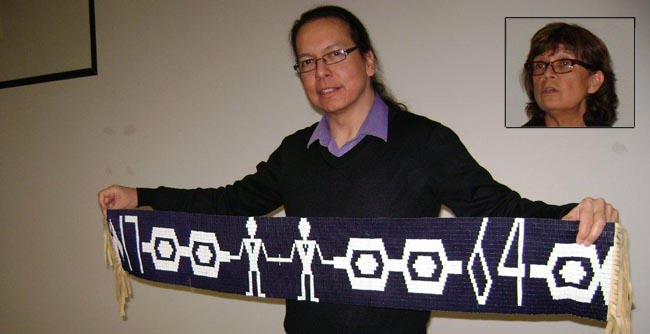Art class gets important lesson in beadwork

By Barb Nahwegahbow
TORONTO – Art students got a different perspective about beads from a February presentation at OCAD (Ontario College and Design) University.
An audience of about 60 heard attended a talk about the significance of wampum for First Nations, hosted by OCAD’s Indigenous Visual Culture Program.
Organizer Bonnie Devine, a citizen of Serpent River First Nation, outlined wampum’s historic use and significance. She is an Associate Professor and the Founding Chair of the Indigenous Visual Culture Program, in addition to being an installation artist, curator and writer.
The white beads, said Devine, were made from whelk shells while the shell of the quahog clam was used to make the purple beads. The painstaking work of turning the shells into beads was left to indigenous women artisans who used stone tools. The job, “required both skills and patience,” she said, “but the result was quite wondrous — tiny lustrous beads that had an almost pearl-like appearance.”
Wampum was traded widely as currency among indigenous nations in Canada, said Devine. The Dutch colonists began using it themselves in trading with the indigenous people of New England. Wampum was declared to be legal tender in New England from 1637 to 1661. Because of its value and its scarcity, the Dutch began to mass-produce wampum in workshops and factories and continued to do so until the early 19th century.
Strings of wampum beads were used, “to record and relay messages, to mark trade exchanges, to secure engagements and marriages…and for political and condolence ceremonies,” Devine said. They were also used as memory aids, “where writing would be encoded in among the strings.” It became a way of recording events or agreements. The symbols used are so simple, said Devine, and yet they are universally legible. “…they transcend language and represent concepts that are sometimes quite abstract and quite difficult to put into text.”
Alan Corbiere, Anishinaabe historian and educator from M’Chigeeng First Nation, has been researching wampum belts since 2002. His introduction to wampum belts was the Covenant Chain entrusted to the Odawa people of Michilimackinac at the 1764 Treaty of Niagara.
His work met with skepticism at first. “I was told, Mohawks have wampum, we don’t have wampum,” Corbiere said. That’s changed, he said, and “…people have started to accept and see the evidence of our wampum tradition as Ojibway, Odawa and Potawatomi people.”
Wampum belts are living documents, said Corbiere, just like the written treaties. He’s written a paper that will soon be published making the argument that wampum is, “what we would call our case law and our common law and these are our precedents. And I’m trying to show how each time they put another belt on, it’s actually another belt reinforcing the previous one.”


